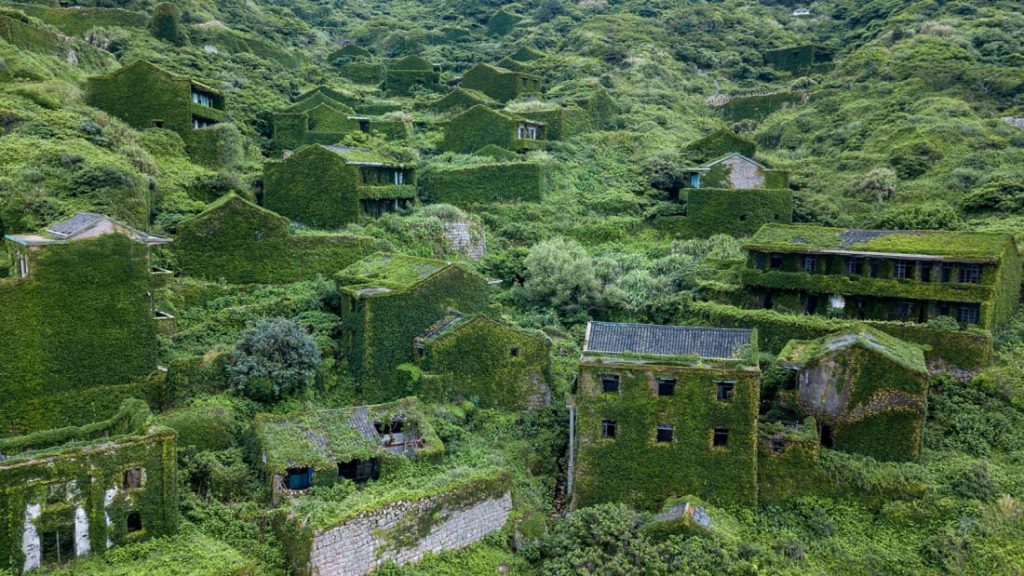The Green Vines Grow All Around
The Shengsi Islands are an archipelago of a few hundred dots of land off the coast of mainland China. (Here’s a map.) The red-flagged island at that link is Shengshan Island, which you can absolutely visit. All you have to do is wake up early enough to catch the once-a-day ferry from Shanghai, which leaves at 9:15 AM according to this travel site. Then, find a seat on the boat and take a break, because it’s three hours until you reach Gouqi Island. If you look at that map again and zoom in on the red flag, you’ll note that Gouqi Island is connected to Shengshan Island by a bridge (seen here), so you’ll probably need to find a taxi to get you the rest of the way. Oh, and you should probably plan on staying the night, too, because the return-trip ferry doesn’t leave Gougi until 7 AM the next day.
So yeah, Shengshan Island is hard to get to. Which is probably why this happened.

That is — or, maybe, was — part of the village of Houtouwan. Originally built in the 1980s as a fishing town, Houtouwan, as you can see, isn’t what it was intended to be. Around 3,000 people moved there and, for about a decade, Houtouwan was thriving. But the lack of infrastructure and the toll of isolation wore down the villages’ residents. To get to Houtouwan, one needed to not only travel as detailed above, but also drive for about half an hour and then take a ten-minute walk to the village — it’s a half-mile or so from the nearest road. For visitors, that’s a lot; for the people who lived there, it effectively meant you were trapped in your town. And as a result, when people left, they often did so with no plans to return. Before the 1990s gave way to the 21st century, Houtouwan was effectively abandoned. And in 2002, the Chinese government made it official, revoking the village’s charter and relocating most of the remaining residents. Only a few remained.
A decade later, nature moved back in, as you can see above. Vines not only took over the paths and roads and whatever else was on the ground, but they also began to thrive on the façades of the buildings and, in some cases, on roofs as well. The image above just gives a taste of nature’s rebound. As seen in this CNN gallery and this BBC photo collection, it’s hard to find spots that aren’t a deep, vibrant green. Really, go click those links. It’s pretty incredible.
In fact, it’s so incredible, that the pictures — like the vines and weeds themselves — have spread widely. In the case of the pictures, though, they’ve been spreading on the Internet. (Like, via email newsletters.) The result? Houtouwan’s fishing industry is gone, but a small tourism industry has blossomed. As CNN reported in 2018, “a new viewing platform opened last year, offering an overview of the village from afar (for a ticket price of $3),” and “visitors can hike around the hilly village for a fee of $8.” Many of the pathways in the somewhat-forsaken village have been cleared to make that doable, and you can spend most of the day in Houtouwan as a result. But that said, you can’t go anywhere you want. Officials have taken some steps to make sure you don’t put yourself at risk; per CNN, “signs are put up outside empty houses to warn tourists about the possible danger of entering the deteriorating structures.”
So while you probably wouldn’t have taken the two-day, ferry-taxi-hike trip to get some fish, many have decided to do so to see the town that nature took back. It’s been a boom for those on Shengshan and Gougi islands; some inns and bed-and-breakfasts have opened as well, and there are a few places to get lunch or dinner, too. In 2017 alone, according to a Chinese government website, the area brought in 670,000 yuan — or about $100,000 — in tourism revenue to those who remain in Houtouwan and the surrounding islands.
Bonus fact: If abandoned towns are your thing but greenery isn’t, how about castles? In 2014, investors in Turkey began construction of Burj Al Babas, a town-to-be featuring 732 luxury homes. But instead of building the typically mansion-like house, the developers decided to create ones built with Cinderella in mind, as seen here and here. (Again, you should click those links.) But, as Architectural Digest explains, “Turkey’s economy came to a grinding stop due to a failed political coup, terrorist attacks, and, of course, the pandemic, and the developers were forced to declare bankruptcy.” None of the homes are completed and most of the buyers and investors have backed out, so if you’re looking for a princess, she’s probably in another castle.
From the Archives: Wonderland, On Ice: Another abandoned Chinese project. And another abandoned castle project.
